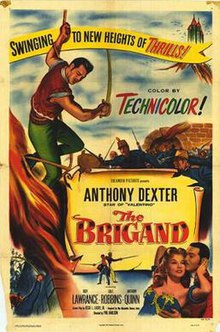Plot
A rogue exile impersonates a King and a virtuous person wants to be so because he is the rightful heir to the throne.
Loosely based on The Brigand by Alexandre Dumas, the film is set in the Napoleonic era in 1804 in the mythical Iberian nation of "Mandorra". The film bears a resemblance to The Prisoner of Zenda by Anthony Hope with Dexter playing a dual role of a rogue exile who impersonates a King in danger of being overthrown by his cousin played by Anthony Quinn.
The scheming Quinn plans a "premeditated accident" to King Lorenzo by giving him a hunting weapon that is rigged to fire backwards. With the real King unable to perform his duties, the swashbuckling distant relative Carlos DeLago, late of the Sultan of Morocco's Guard steps in to save the Kingdom.
Production
In May 1949 it was reported that producer Edward Small had hired Robert Libott, and Frank Burt to write a script. [1] In December 1949 Small signed a two-year contract with Columbia Pictures to make "projects he had been developing for some time," "two to six" films, starting with adventure film Lornna Doone (1951) directed by Phil Karlson. [2]
At the same time, Small had another contract with Columbia to distribute Valentino (1951), his biopic of Rudolph Valentino starring Anthony Dexter. [3] In August 1950 Small announced that he would make two films fot Columbia starring Dexter, The Brigand, and a remake of Valentino's 1921 romantic drama The Sheik . [4]
In May 1951 Jesse L. Lasky, Jr., who worked on Lornna Doone, was reportedly writing the script of the film [5] while Karlson was announced as director. Several actors return too: Carl Benton Reid, Ron Randell, [6] and Lester Matthews.
Filming started 9 July 1951. [7] After the production, Small left Columbia to return to United Artists. [8]
This page is based on this
Wikipedia article Text is available under the
CC BY-SA 4.0 license; additional terms may apply.
Images, videos and audio are available under their respective licenses.
